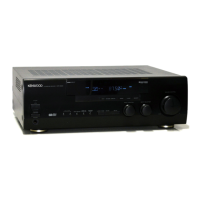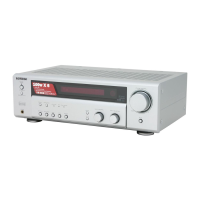Do you have a question about the Kenwood KRF-V5100D and is the answer not in the manual?
Essential safety warnings and precautions for operating the unit to prevent hazards.
Guides on connecting components like DVD players, audio, video, digital, speakers, and antennas.
Procedures for preparing playback, listening to sources, adjusting sound, and recording.
Basic operations for controlling the unit and KENWOOD DVD players using the remote.
Covers cleaning, ventilation, power sources, accessories, and installation precautions.
Addresses polarized plugs, power cords, lightning, servicing, replacement parts, and damage requiring service.
Details on water exposure, overloading, object entry, heat sources, power lines, and antenna grounding.
Detailed instructions for connecting a DVD player using 6-channel digital connections.
Steps for connecting various audio sources like cassette decks, MD recorders, and CD/DVD players.
Instructions for connecting video sources such as video decks and monitors using S-VIDEO jacks.
Covers Dolby Digital EX, Pro Logic IIx, DTS-ES, and Neo:6 for immersive audio experiences.
Includes DSP modes, DVD 6-channel input, ACTIVE EQ, IR remote, and RDS tuner functions.
Detailed labeling and explanation of the front panel controls and indicators of the receiver.
Identification of controls on the remote unit for operating the receiver and DVD players.
Describes functions of various keys on the remote for input selection, listening modes, and adjustments.
How to select and configure input modes (Auto Detect, Manual, 6CH INPT, Analog) for optimal signal reproduction.
Detailed instructions for connecting a DVD player using 6-channel digital connections.
Steps for connecting various audio sources like cassette decks, MD recorders, and CD/DVD players.
Instructions for connecting video sources such as video decks and monitors using S-VIDEO jacks.
Guide for connecting video components using COMPONENT VIDEO jacks for higher picture quality.
How to connect digital sources like DTS, Dolby Digital, or PCM signals using coaxial or optical cables.
Step-by-step guide for connecting front, center, surround, and surround back speakers.
Instructions for connecting AM loop and FM indoor/outdoor antennas for broadcast reception.
Details on connecting speaker cords, checking impedance, and speaker placement guidelines.
Guide to setting up speaker parameters like room type, listening position, and size for optimal sound.
Step-by-step guide for custom configuration of subwoofer, front, center, and surround speakers.
Guide to adjusting individual speaker volume levels using test tones for balanced output.
Procedure to adjust the subwoofer's low-frequency effects level for enhanced bass.
How to adjust analog input signal levels to prevent clipping and maintain sound quality.
Initial steps before starting playback, including turning on the system and selecting input modes.
How to select and listen to audio from connected source components.
How to turn the speakers on or off using the SPEAKERS ON/OFF button.
Fine-tuning sound quality with options like Loudness, Mute, Tone, Bass Boost, and Active EQ.
How to use the ACTIVE EQ mode for a more impressive sound effect during playback.
Steps for connecting and using headphones with the unit.
Steps for recording analog audio sources from components like CD/DVD players.
Instructions for recording video sources to a connected video deck.
How to record digital audio sources using A-REC or M-REC modes.
Method for tuning standard FM and AM radio stations manually or automatically.
Explanation of RDS features like PTY search, PS display, and Radio Text.
Steps to store AM, FM, and RDS stations into preset memory.
Steps to store AM, FM, and RDS stations into preset memory.
How to recall stored radio stations using numeric keys or sequential access.
How to sequentially receive stored radio stations using the P.CALL keys.
How to cycle through RDS display modes: PS, RT, and Frequency.
Automatic storage of up to 40 RDS stations into preset memory.
Search for radio stations broadcasting specific program types (genres).
Explains speaker placements for 5.1, 6.1, and 7.1 channel surround systems and their effects.
Details Dolby Digital and its EX extension for enhanced surround sound quality and channels.
Features of Dolby Pro Logic IIx and II for converting stereo/Dolby Surround to multi-channel sound.
Description of DTS-ES formats and Neo:6 technology for extended surround sound.
How to select listening modes for Dolby Digital, DTS, and analog/digital sources for optimal playback.
Guide to enjoying surround sound from DVD players with 6-channel outputs.
Special features for sound adjustment like Midnight mode, Panorama, and Dimension.
Fine-tuning sound quality with options like Loudness, Mute, Tone, Bass Boost, and Active EQ.
Adjusting soundfield for music playback to achieve balance across speakers.
Adjusting center image for enhanced sound with center speaker or combinations.
Selecting display brightness levels for viewing movies or listening to music.
Explanation of the remote control keys used for basic DVD player functions.
Procedure to reset the unit's microcomputer in case of malfunction or erroneous display.
Solutions for common amplifier issues like no sound, intermittent sound, or soft speaker output.
Solutions for tuner issues such as no reception, interference, or preset station problems.
Solutions for issues where the remote control operation is not possible.
Essential safety warnings and precautions for operating the unit to prevent hazards.
Guides on connecting components like DVD players, audio, video, digital, speakers, and antennas.
Procedures for preparing playback, listening to sources, adjusting sound, and recording.
Basic operations for controlling the unit and KENWOOD DVD players using the remote.
Covers cleaning, ventilation, power sources, accessories, and installation precautions.
Addresses polarized plugs, power cords, lightning, servicing, replacement parts, and damage requiring service.
Details on water exposure, overloading, object entry, heat sources, power lines, and antenna grounding.
Detailed instructions for connecting a DVD player using 6-channel digital connections.
Steps for connecting various audio sources like cassette decks, MD recorders, and CD/DVD players.
Instructions for connecting video sources such as video decks and monitors using S-VIDEO jacks.
Covers Dolby Digital EX, Pro Logic IIx, DTS-ES, and Neo:6 for immersive audio experiences.
Includes DSP modes, DVD 6-channel input, ACTIVE EQ, IR remote, and RDS tuner functions.
Detailed labeling and explanation of the front panel controls and indicators of the receiver.
Identification of controls on the remote unit for operating the receiver and DVD players.
Describes functions of various keys on the remote for input selection, listening modes, and adjustments.
How to select and configure input modes (Auto Detect, Manual, 6CH INPT, Analog) for optimal signal reproduction.
Detailed instructions for connecting a DVD player using 6-channel digital connections.
Steps for connecting various audio sources like cassette decks, MD recorders, and CD/DVD players.
Instructions for connecting video sources such as video decks and monitors using S-VIDEO jacks.
Guide for connecting video components using COMPONENT VIDEO jacks for higher picture quality.
How to connect digital sources like DTS, Dolby Digital, or PCM signals using coaxial or optical cables.
Step-by-step guide for connecting front, center, surround, and surround back speakers.
Instructions for connecting AM loop and FM indoor/outdoor antennas for broadcast reception.
Details on connecting speaker cords, checking impedance, and speaker placement guidelines.
Guide to setting up speaker parameters like room type, listening position, and size for optimal sound.
Step-by-step guide for custom configuration of subwoofer, front, center, and surround speakers.
Guide to adjusting individual speaker volume levels using test tones for balanced output.
Procedure to adjust the subwoofer's low-frequency effects level for enhanced bass.
How to adjust analog input signal levels to prevent clipping and maintain sound quality.
Initial steps before starting playback, including turning on the system and selecting input modes.
How to select and listen to audio from connected source components.
How to turn the speakers on or off using the SPEAKERS ON/OFF button.
Fine-tuning sound quality with options like Loudness, Mute, Tone, Bass Boost, and Active EQ.
How to use the ACTIVE EQ mode for a more impressive sound effect during playback.
Steps for connecting and using headphones with the unit.
Steps for recording analog audio sources from components like CD/DVD players.
Instructions for recording video sources to a connected video deck.
How to record digital audio sources using A-REC or M-REC modes.
Method for tuning standard FM and AM radio stations manually or automatically.
Explanation of RDS features like PTY search, PS display, and Radio Text.
Steps to store AM, FM, and RDS stations into preset memory.
Steps to store AM, FM, and RDS stations into preset memory.
How to recall stored radio stations using numeric keys or sequential access.
How to sequentially receive stored radio stations using the P.CALL keys.
How to cycle through RDS display modes: PS, RT, and Frequency.
Automatic storage of up to 40 RDS stations into preset memory.
Search for radio stations broadcasting specific program types (genres).
Explains speaker placements for 5.1, 6.1, and 7.1 channel surround systems and their effects.
Details Dolby Digital and its EX extension for enhanced surround sound quality and channels.
Features of Dolby Pro Logic IIx and II for converting stereo/Dolby Surround to multi-channel sound.
Description of DTS-ES formats and Neo:6 technology for extended surround sound.
How to select listening modes for Dolby Digital, DTS, and analog/digital sources for optimal playback.
Guide to enjoying surround sound from DVD players with 6-channel outputs.
Special features for sound adjustment like Midnight mode, Panorama, and Dimension.
Fine-tuning sound quality with options like Loudness, Mute, Tone, Bass Boost, and Active EQ.
Adjusting soundfield for music playback to achieve balance across speakers.
Adjusting center image for enhanced sound with center speaker or combinations.
Selecting display brightness levels for viewing movies or listening to music.
Explanation of the remote control keys used for basic DVD player functions.
Procedure to reset the unit's microcomputer in case of malfunction or erroneous display.
Solutions for common amplifier issues like no sound, intermittent sound, or soft speaker output.
Solutions for tuner issues such as no reception, interference, or preset station problems.
Solutions for issues where the remote control operation is not possible.
| Channels | 5.1 |
|---|---|
| Frequency Response | 20Hz to 20kHz |
| Total Harmonic Distortion (THD) | 0.08% |
| Input Sensitivity | 200mV (line) |
| Signal-to-Noise Ratio | 100 dB |
| Tuning range | FM: 87.5 - 108 MHz, AM: 530 - 1710 kHz |
| Digital inputs | Optical, Coaxial |
| Video Connections | Composite, S-Video |
| Speaker Impedance | 6 - 16 ohms |
| Tuner Section | FM/AM |
| Power Output | 100W per channel (8 ohms, 20Hz-20kHz, 0.08% THD) |












